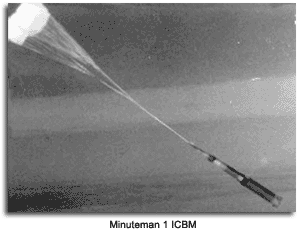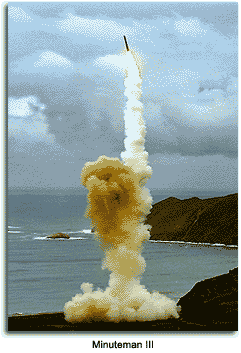The Minuteman was the first United States solid-fueled ICBM and its third operational system. As the name suggests, one of its advantages over the predecessor liquid-fueled Inter-Continental Ballistic Missiles, the Atlas and Titan rockets, was its ability to be launched quickly. The first two models were succeeded by a third, which has remained the mainstay of American land-based missile capabilities for more than three decades.
 The first planning for the Minuteman began in the mid-1950s. The project was underway by mid 1957 and officially announced in 1958. Boeing Airplane Company was named the primary contractor. The first test launch took place at Cape Kennedy in 1961, with the first deployment of the Minuteman I at Malstrom Air Force Base in Montana in 1962. Known as America’s “Ace in the Hole,” the Minuteman was at the ready during the Cuban Missile Crisis.
The Minuteman had several advantages. It could be launched quickly from a hardened silo, making it a formidable counter-threat to any Soviet first strike. It was also cheap and accurate, so that it could be deployed in vast numbers and guaranteed the destruction of the Soviet Union's ability to wage a continued war.
Production of the Minuteman I ended in 1965 and the missiles were soon replaced with the improved Minuteman II, which had a greater accuracy. The Minuteman II remained in service until 1994. The third model, the Minuteman III, introduced the MIRV into the United States missile arsenal. With the ability to deliver three warheads within even greater precision, the Minuteman III actually delivered more militarily useful destruction with smaller bombs.
The first planning for the Minuteman began in the mid-1950s. The project was underway by mid 1957 and officially announced in 1958. Boeing Airplane Company was named the primary contractor. The first test launch took place at Cape Kennedy in 1961, with the first deployment of the Minuteman I at Malstrom Air Force Base in Montana in 1962. Known as America’s “Ace in the Hole,” the Minuteman was at the ready during the Cuban Missile Crisis.
The Minuteman had several advantages. It could be launched quickly from a hardened silo, making it a formidable counter-threat to any Soviet first strike. It was also cheap and accurate, so that it could be deployed in vast numbers and guaranteed the destruction of the Soviet Union's ability to wage a continued war.
Production of the Minuteman I ended in 1965 and the missiles were soon replaced with the improved Minuteman II, which had a greater accuracy. The Minuteman II remained in service until 1994. The third model, the Minuteman III, introduced the MIRV into the United States missile arsenal. With the ability to deliver three warheads within even greater precision, the Minuteman III actually delivered more militarily useful destruction with smaller bombs.
 With the retirement of the Minuteman II and the Peacemaker (MX) ICBMs, the Minuteman III has become the sole land-based component of America's missile system. It has a planned retirement in 2020, at which time the Minuteman IV is scheduled to replace it. However, no development work on the successor has yet begun.
With the retirement of the Minuteman II and the Peacemaker (MX) ICBMs, the Minuteman III has become the sole land-based component of America's missile system. It has a planned retirement in 2020, at which time the Minuteman IV is scheduled to replace it. However, no development work on the successor has yet begun.